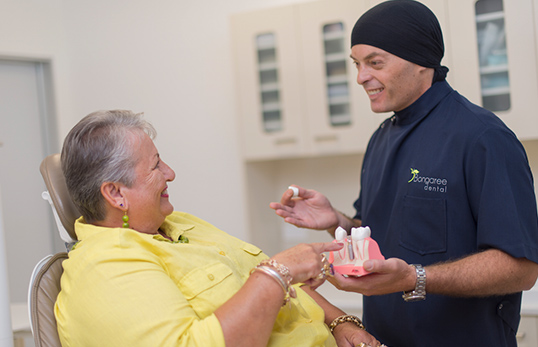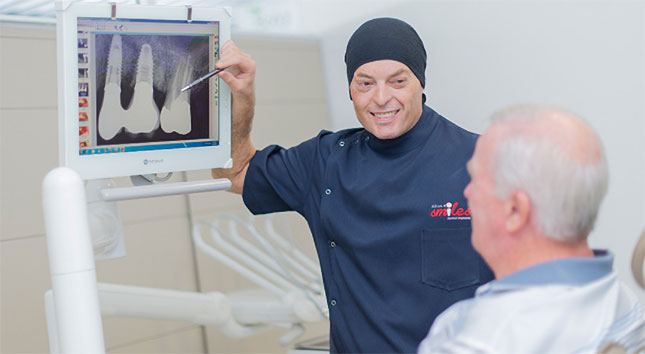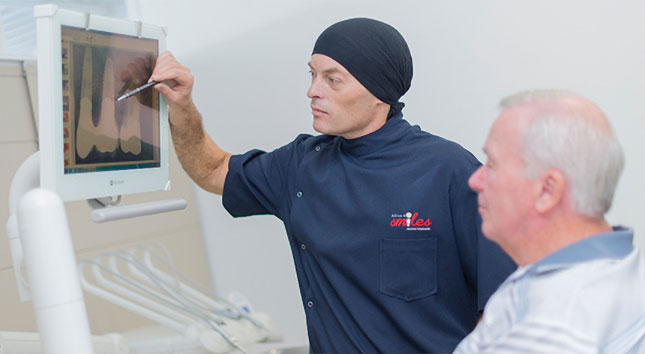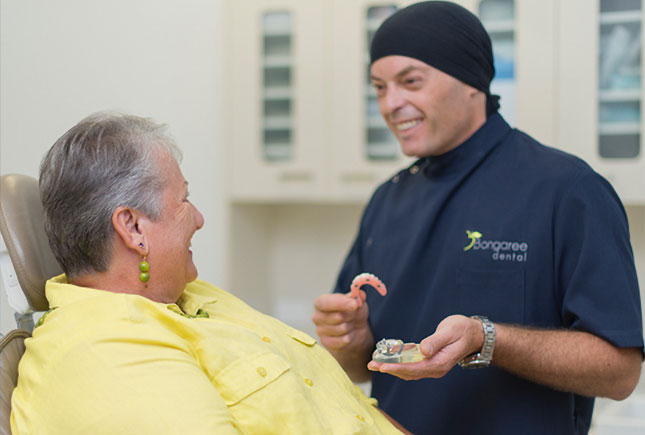
A single implant can be inserted into the jawbone in approximately the same position as the missing tooth root. The implant post is left to heal, a process called Osseointegration which enables it to fully integrate with the surrounding jawbone so it creates a stable platform for the replacement tooth. While your implant heals, we will fit a temporary tooth so you need not worry about having a gap in your smile. Once the healing process is complete, we will attach your new tooth that will look and feel just like your own.
We can place dental implants to restore multiple missing teeth. It is not necessary to replace every tooth with a dental implant; we can make quite large dental bridges that are supported with relatively few implants. After we have inserted your implants they will be left to heal before your new bridge is secured onto the implant posts. A temporary bridge can restore your smile during the healing period.
Are you faced with the prospect of losing all your natural teeth, or perhaps you already wear full dentures? We know dentures are not an ideal choice for replacing missing teeth which is why we are pleased to offer a better and more permanent solution.
Dental implants is a procedure to replace your dentures with a fixed bridge of teeth, supported by four carefully positioned dental implants. Once treatment is completed you will have fully functional teeth, enabling you to enjoy a far greater choice of foods and you will be able to talk and laugh with complete confidence.
Your new teeth are custom-designed to suit your features and your personality, providing the very best aesthetics. In most cases we will be able to fit your permanent teeth just three days after your implants have been inserted.
Most patients will be suitable for this procedure, even those with very little bone for dental implants and who may have been missing their natural teeth for many years. The easiest way to find out is to book a consultation with our implant dentist.

We will recommend a sinus lift if your CT scan shows insufficient bone for dental implants as they must be surrounded by a certain amount of strong and healthy bone for treatment to be successful. A sinus lift adds bone to your upper jaw, in the region of your upper premolars and molars prior to the placement of dental implants. It is quite common for bone to be thinner around this area, especially if you lost teeth quite some time ago or had an infection or gum disease.
The new artificial bone is added in between your jaw and the sinus cavities either side of your nose during a surgical procedure. If you only require a small amount of bone then we may be able to place your dental implant at the same time. Otherwise we will allow your sinus graft time to heal before inserting the implant.
Sinus lifts are very common and we plan this surgery extremely carefully so it is trouble-free and smooth for our patients.
We plan each dental implant procedure extremely carefully, using diagnostic tests such as x-rays and a CT scan. It is not unusual for these tests to show there is insufficient bone to support a dental implant, in which case we will recommend a bone graft. We might also want to build up the bone to provide better aesthetic results once your implant is fully restored with your new tooth. Even though this might sound slightly alarming, it is important to remember a bone graft is a routine and painless procedure, providing highly predictable results and we use only the highest quality bone grafting materials. In some cases it may be possible to place the implant at the same time as the graft but otherwise we might need to allow additional healing time before inserting your implant.


Ordinary dentures are a popular choice for replacing entire arches of teeth but are often less than the perfect solution. Often wearers will find they move and slip, making it difficult to eat and speak. Dental implants can solve this problem and it only takes between two and four implants to securely hold a denture.
Every procedure for an implant retained denture is carefully planned and customised to ensure the implants are inserted in the best position to provide maximum stability. Once inserted into the jaw, the implants will soon fuse with the surrounding bone, creating solid anchors for your implant retained denture.
Your implant retained denture will have special attachments on its fitting surface (the surface closest to your gums) and these will clip onto attachments on the implants. The final result should be a fully functional and completely stable denture, but you will still be able to remove it for cleaning and maintenance. Advantages of choosing an implant retained denture include:
Enquire Now! Call us on 07 3410 1610 or 07 3543 0018